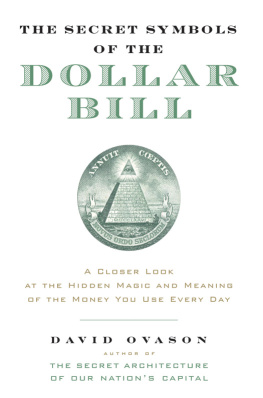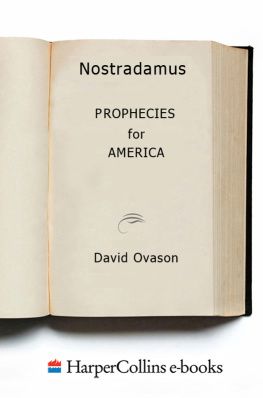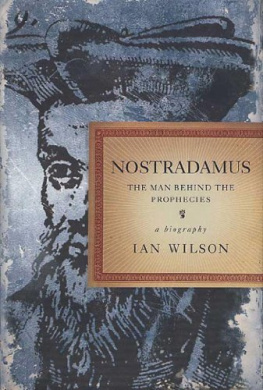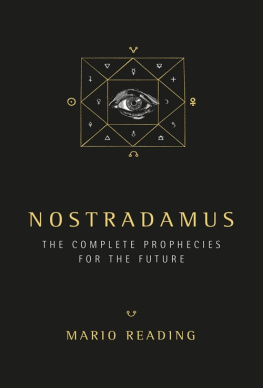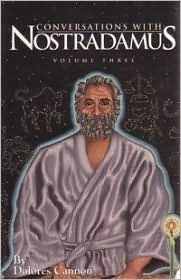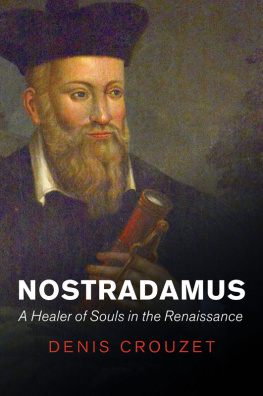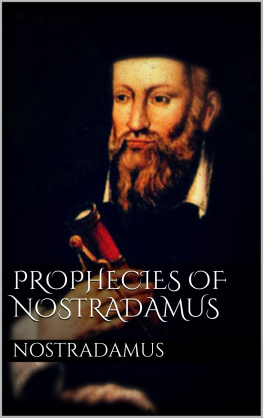I know the hazzard of Interpretation I will not pretend a familiarity with the Stars nor to unriddle all the dark Nonsense of Nostradamus; but something sure there is in all those things.
(The Fortunes of France from the Prophetical Predictions of Mr. Truswell, the Recorder of Lincoln, and Michel Nostradamus, 1678)
T he purpose of this book is to reveal, for the first time, the secret methods used by Michel Nostradamus, when he penned his famous prophetic writings, published as the Prophties.
The general reader may be surprised that these secrets have not been revealed before. After all, it is widely believed that the oracular verses of Nostradamus have already been translated, and that the details of his predictions are well known to scholars. However, as we shall demonstrate, this is a fiction: all translations currently available in the West are largely nonsensical, and have little or no bearing on what Nostradamus intended to say. Here we attempt to pierce through all the obfuscation and poor scholarship, to reach into the mind of this remarkable savant, who had the rare gift of unrolling the scroll of futurity.
The past three decades have witnessed a revolution in Nostradamus studies. A great deal of research into his life and work has been conducted by French historians (among them Robert Amadou, Robert Benazra, Michael Chomarat, Jean Dupbe and Edgar Leroy), with the result that an entirely new light has been thrown on his biography, achievements and astrological methods, clarifying certain difficulties which arise from his predictive quatrains.*
Unfortunately, few of the implications of this research have reached the popular marketthe publishing bandwagon of the sub-cultural literature attached to Nostradamus. This deficiency is especially prevalent in the sub-cultural Nostradamian literature in English. In spite of the brilliant insights offered by the modern French school of criticism, popular writers have continued to issue biographies of Nostradamus and commentaries on his Prophties which are replete with errors that modern research scotched long ago. One of our aims is to rectify this deficiency.
In addition to these extraordinary discoveries, material which was once so rare as to be accessible only to a handful of privileged scholars has been made available on a much wider basis by way of facsimile publication. For example, the recent facsimile reproduction of a rare Almanach by Nostradamus, and of a book of quatrains, published while Nostradamus was still alive, has helped enormously in clarifying some of the historical difficulties which earlier writers had no way of dealing with. Equally, the modern reprint of the extremely rare edition of the Prophties of 1557 has facilitated the study of the early quatrains (fig. 1). We shall examine each of these developments in due course: it is sufficient here to say that the time has come not only for a reappraisal of the quatrains of Nostradamus, in order to demolish once and for all the unscholarly writings of sub-cultural commentators, but also for a reappraisal of the life of Nostradamus, to bring the details of his biography up to date with the findings of modern scholarship.
In spite of the painstaking researches of modern French scholars, a full survey of the life and times of the savant has still to appear. In consequence, for all its importance to the development of the predictive verses, we have merely glanced at his life in the present work. Even so, we have attempted to incorporate into our findings the insights gained by scholars during the past few decades. This has helped us achieve our aim, which has been to record the arcane methods and prophetic aspirations of Nostradamus against their historical context.
The predictive verses of Nostradamus, written in the middle of the sixteenth century, dealt entirely with events which were then still in the future. It is clear from notes left by Nostradamus that the quatrains covered events beginning about one year after the publication of his first volume of verses, extending in the future for just over 800 years. This period was linked with the movements of the planets Jupiter and Saturn, which completed a special cycle in that number of years. The cycle was sometimes called the period of the superiors, as, in the Ptolemaic geocentric model, the two planets were believed to be in orbit above (hence, superior to) the Sun. Nostradamus main interest lay in events in the first three centuries following his own lifetime, which means that a great number of his predictions have been fulfilled, and have revealed to those familiar with oracles the extraordinary precision of his vision. So accurate are the details and dates which Nostradamus gave in these verses that one is left with the eerie feeling that what he saw was, in some mysterious way, already a precisely determined history, rather than a nebulous vision of futurity. It is on this super-clairvoyancy that his fame and popularity rests, even if this fame has, until now, been based on a misunderstanding concerning his visions, and how he expressed them in words.
Most of the quatrains are, or were, prophetic. So far as we can see, they deal mainly with European historyespecially with the history of France, Italy and England. In one or two quatrains, Nostradamus glanced at the European offshoot, the United States, and at historical events in places which were, in his day, well beyond the periphery of Europe: Turkey, Syria and the Eastern Mediterranean seaboard. Almost certainly, he is the first clairvoyant to mention America by name, at a time when the word was not even widely used to denote the newly rediscovered continents.
At least 40 of his obscure quatrains appear still to relate to our own future, but remain beyond detailed interpretation. No doubt the modern reader, like Nostradamus own contemporaries, will take up this book in the hope of insights into this coming futurity, just as all readers in the past sought in their own interpretations of Nostradamus predictions confirmation of their hopes and fears. We shall (with some trepidation) examine the possible significance of a few of these future quatrains in the following text: however we have not approached Nostradamus purely in a spirit of inquiry about what the future holds for Europe in the next few centuries. As this book will reveal, our real interest lies elsewhere.
Our concern is with the arcane method used by Nostradamus. Our conviction is that it is only by understanding the technique of oracular writing which he used that we shall be able to interpret correctly what he intended to say about what was his future, but which is now in our past.
The quatrains of the Prophtiesfulfilled or yet to be fulfilledremain the supreme example of a lost esoteric literature.
The quatrains contain a fascinating conflict. On the one hand, there is no doubt whatsoever that Nostradamus intended to record the future, and to sketch out the main drift of European events, spanning a period of about 800 years. However, there is also no doubt that Nostradamus did not intend these carefully crafted prophecies to be understood until


